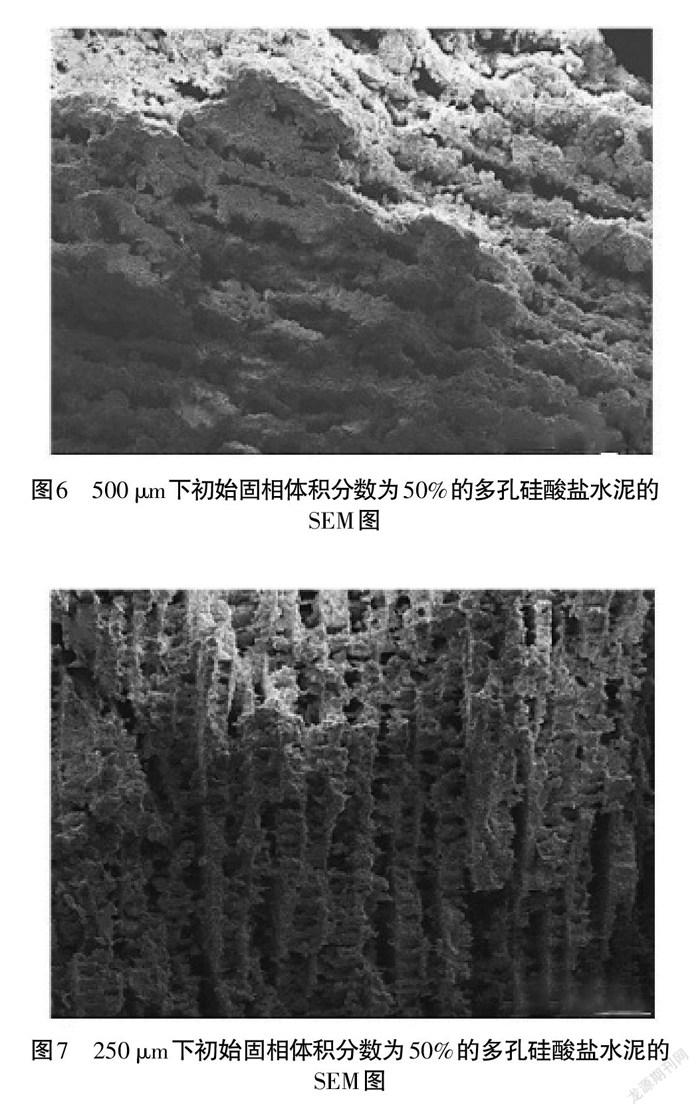水泥基多孔材料的研究进展
2022-04-20阿拉腾沙嘎蒙永昊陈星陈冠宏
阿拉腾沙嘎 蒙永昊 陈星 陈冠宏






摘 要:为满足我国建筑业快速发展的需要,近年来研究人员正在开发和改进具有不同结构和功能的水泥基材料,其中水泥基多孔材料作为重要的一种被广泛研究。笔者首先介绍了水泥基多孔材料的结构和性能特点,然后综述了发泡法、添加轻骨料法和冷冻铸造法制备水泥基多孔材料的研究进展,重点阐述了水泥基多孔材料的结构和性能之间的响应关系,展望了水泥基多孔材料的发展前景。
关键词:多孔结构;水泥基;结构和性能;功能材料
中图分类号:TU528 文献标志码:A 文章编号:1003-5168(2022)5-0028-05
DOI:10.19968/j.cnki.hnkj.1003-5168.2022.05.006
Research Progress of Cement-Based Porous Materials
Alateng Shaga1 MENG Yonghao2 CHEN Xing3 CHEN Guanhong4
(School of Materials Science and Engineering, Jilin Jianzhu University, Changchun 130117,China)
Abstract: To meet the needs of rapid industrial development in China, cement-based materials with different structures and functions are being developed and improved at a deep level, and cement-based porous materials, as one of their important teams, have been widely studied in recent years. The author firstly introduces the structure and performance characteristics of cement-based porous materials, and then reviews the research progress on the preparation of cement-based porous materials by foaming method, Introduction of light aggregates and freeze casting method, focuses on the response relationship between structure and performance of porous materials, and looks forward to the development prospect of inorganic functional materials.
Keywords: functional materials; porous structure; cement-based; structure and properties
0 引言
水泥基多孔材料在土木工程建設中不仅作为一种结构材料使用,而且发挥着保温、吸附、噪声吸收等功能[1-5]。水泥基多孔材料是由孔隙及其旁壁组成,具有网状结构。常见的水泥基多孔材料包括加气混凝土、泡沫混凝土和轻骨料混凝土等[6]。多孔水泥基材料因其重量轻、节材、隔热、吸声、抗震性能好等优点,广泛应用于民用和工业建筑的保温、吸声和工业废水重金属去除[7-8]。超轻化的水泥基多孔材料具有气孔结构,在一定程度上提高了它的保温、吸声等性能,但不可避免降低材料力学性能,难以有效兼顾材料功能与力学性能,限制了其大规模应用。研究水泥基多孔材料不同的制备工艺对其结构和性能的影响,对发展绿色节能建材具有重要意义[7-8]。
1 水泥基多孔材料的制备
水泥基多孔材料的孔结构是决定其性能的关键因素,成为广大学者的研究核心[9-10]。与传统的混凝土相比,水泥基多孔材料中除了水化反应产生凝胶和毛细孔外,还能在制备过程中通过使用冰模板(即冷冻铸造法)、预制泡沫、轻骨料或添加加气剂(铝粉、过氧化氢等)获得人工孔结构。表1汇总了最近采用以上方法制备的水泥基多孔材料的研究进展。
1.1 发泡法
制备水泥基多孔材料的发泡法根据发泡方式的不同可以分为物理发泡法和化学发泡法。在物理发泡中,通过将预发泡或气体发泡工艺产生的气泡引入到新拌合的混凝土中以产生多孔结构[22,23]。而化学发泡法是利用无机化合物与水泥发生的化学反应产生气体,从而形成内部多孔结构。Luan[14]等人采用直接发泡法制备了基于硅镁土(AT)的磷酸镁多孔材料(AT-MPPCM),微观结构如图1和图2所示。该材料具有优异的力学性能、孔隙率和高吸附性。他们研究了不同AT和水的加入量对磷酸镁多孔复合材料力学性能和孔隙率的影响。试验表明,随着硅镁土和水的增多,AT-MPPCM样品的抗压强度和孔隙率均呈现出先增后减的变化趋势,如图3和图4所示。图中M1-1- M1-5表示AT所占固相质量分数为10%~50%,M2-1- M2-5表示含水率为26.66%~30.37%。在AT所占固相比为30%、含水率为30.37%的条件下,AT-MPPCM的孔隙率和抗压强度达到最高,分别为79.02%和2.87 MPa。这是由于AT和水的加入延长了其凝结时间,混合物的流动性得到改善,促进了内部的水化反应,形成稳定的孔隙结构,从而提高了孔隙率和抗压强度。但随着继续添加,浆料的固相含量降低,气泡之间的膜壁变薄。当发生水化反应时,膜破裂形成不均匀的孔隙结构,导致孔隙率和抗压强度降低。
Fu[13]等人以锌粉为发泡剂,通过与二氢铵(NH4H2PO4)溶液释放的氢离子反应,产生氢气制备了磷酸镁水泥基多孔材料(MPCPM)。试验从锌粉含量、水灰比和NH4H2PO4的粒径等方面系统地研究了对MPCPM的黏度、温度变化、抗压强度、抗折强度和导热系数的影响。结果表明,随着锌粉含量和水灰比的增加,浆料的硬化时间延长,黏度值增加,水化温度降低,机械强度降低,导热系数降低。NH4H2PO4的粒径对MPCPM性能的影响与锌粉含量对W/S的影响相似。研究表明,磷酸镁水泥基多孔材料在保温隔热、吸声隔音等领域有着很好的应用前景。
1.2 添加轻骨料
随着制备水泥基多孔材料方法的层出不穷,学者们利用轻骨料内部孔隙和轻骨料互相之间堆积产生大量微空隙的特性,通过将预制轻骨料与水泥混合制备出具有稳定的孔结构的水泥基多孔材料。常见的轻骨料有玻璃微珠(GB)、膨脹珍珠岩、浮石骨料、粉煤灰、空心微珠、纳米二氧化硅球和纳米二氧化硅气凝胶等[24-27]。
Vaganov[24]等人通过添加轻质骨料—泡沫玻璃颗粒并结合化学发泡技术制备了高性能轻质水泥基多孔材料。他们研究对比了添加泡沫玻璃颗粒对水泥基多孔材料微观结构和力学性能的影响。结果表明,轻骨料的引入会促进C-S-H凝胶的孔隙中微晶体的生长,水泥浆的孔隙率减少,混凝土的孔隙结构被压实。由于混凝土的多孔结构发生变化,导致抗压强度增加。另外,由于孔隙结构的改变,降低了水泥基多孔材料的导热率。Gao[18]等人通过将二氧化硅气凝胶颗粒掺入混凝土中,制备了轻质和绝热水泥基多孔材料,并研究了气凝胶含量与水泥基样品的密度、热和力学性能之间的相关性。研究结果显示,随着气凝胶含量的增加,水泥基多孔材料的密度、导热性和机械强度呈线性下降趋势,而且气凝胶颗粒在水泥基材料的水化过程中是稳定的,这表明将气凝胶和水泥/混凝土材料用于施工具有可能性。
1.3 冷冻铸造法
冷冻铸造法,也被称为冰模板法,由于成本低廉,操作简便,环境友好,普适性强,已被证明是制备具有复杂和分层结构多孔材料的一种新型制备工艺[28]。与上述方法相比,经冷冻成型方法制备的水泥基多孔材料可获得更精细化片层尺度、孔隙率高、形状复杂多变、性能较好的特点。冷冻铸造工艺包括四个步骤:浆料配制、定向凝固、冷冻干燥和养护,如图5所示[20]。
在冷冻铸造过程中,浆料中溶剂的选择是影响水泥基材料内部孔结构的关键因素。2016年Dong[20]等人用以叔丁醇作为有机溶剂混合硅酸盐水泥利用冷冻铸造技术制备了具有多级孔隙率的管状多孔压块。系统研究了影响大孔尺寸、中孔尺寸、孔隙率和抗压强度的各种试验参数,包括初始固体含量、冻结温度和固化时间。结果表明,随着冻结温度的降低和固相含量的增加,孔径显著减小,抗压强度显著提高。此外,除了它们可调的物理特性之外,硅酸盐水泥材料具有定向排列的孔隙结构和致密的层表面,表现出高渗透性能和理想的分层能力。这些结果使得硅酸盐水泥这种低成本、高性能的建筑材料作为一种新型有序多孔无机材料具有巨大的应用潜力[21]。2018年Dong[29]等人在通过结合冰模板和水化反应途径制备出具有三种不同陶瓷含量的分层多孔硅酸盐水泥,即陶瓷体积分数分别为40%、50%和60%的样品,如图6和图7所示。
经对比发现,随着浆料浓度的提高,浆料中的水含量较少,样品表面积从86.744 m2/g降至70.707 m2/g,孔隙率从61.8%降低至47.62%,同时层间距减小,抗压强度从10.76 MPa增加到16.67 MPa,如图8和图9所示[29]。
2 结论
本文系统地总结了采用发泡法、引入轻骨料和冷冻铸造法制备水泥基多孔材料的研究进展,重点阐述了三种制备方法的工艺参数、材料的微观结构和材料性能之间的响应关系和影响规律。虽然目前水泥基多孔材料的制备得到较好发展,但很难控制制备过程中水化反应速率以及强度和孔隙率之间的平衡,需要继续优化制备工艺流程以及工艺参数,探究新型水泥基多孔材料的制备,拓展其潜在应用领域。
参考文献:
[1] SWARTZ M L, PHILLIPS R W, CLARK H E. Long-term F release from glass ionomer cements.[J]. Journal of Dental Research,1984,63(2):158-60.
[2] HEWLETT P C.Lea's Chemistry of Cement and Concrete. Elsevier Butterworth Heinemann[M].Butterworth-Heinemann,2004.
[3]KUMAR S,KUMAR R,BANDOPADHYAY A,et al.Mechanical activation of granulated blast furnace slag and its effect on the properties and structure of portland slag cement[J]. Cement and Concrete Composites,2008.
[4] SCRIVENER K L, CAB IRON J L, LETOURNEUX R. High-performance concretes from calcium aluminate cements[J]. Cement & Concrete Research,1999,29(8):1215-1223.
[5] ZHANG J, WEISSINGER E A, PEETHAMPA-RAN S, et al. Early hydration and setting of oil well cement[J]. Cement & Concrete Research,2010,40(7):1023-1033.
[6] Hilal A A, Thom N H, Dawson A R. On entrained pore size distribution of foamed concrete[J]. Construction and Building Materials, 2015, 75: 227-233.
[7] WANG Z, LIU L, ZHOU J, et al. Impacts of potassium permanganate (KMnO4) catalyst on properties of hydrogen peroxide (H2O2) foamed porous cement slurry[J]. Construction & Building Materials, 2016, 111(15): 72-76.
[8] PANESAR D K. Cellular concrete properties and the effect of synthetic and protein foaming agents[J]. Construction & Building Materials, 2013, 44(7): 575-584.
[9] PARK S B, SEO D S, LEE J. Studies on the sound absorption characteristics of porous concrete based on the content of recycled aggregate and target void ratio[J]. Cement & Concrete Research, 2005, 35(9): 1846-1854.
[10] NARAYANAN N, RAMAMURTHY K. Structure and properties of aerated concrete: a review[J]. Cement and Concrete Composites, 2000, 22(5): 321-329.
[11] 全明,李玉香.水泥基吸聲材料多孔与穿孔结构的吸声性能研究[J].新型建筑材料,2017(44):67-70.
[12] 郭盼盼,张云升,宁瑶瑶.轻质水泥基多孔材料的制备及基本性能研究[J].新型建筑材料,2020,47(10):147-152.
[13] FU X, LAI Z, LAI X, et al. Preparation and characteristics of magnesium phosphate cement based porous materials[J]. Construction and Building Materials, 2016, 127: 712-723.
[14] LUAN X, LI J, YANG Z. Effects of attapulgite addition on the mechanical behavior and porosity of cement-based porous materials and its adsorption capacity[J]. Materials Chemistry and Physics, 2019, 239: 121962.
[15] 李青,酆磊,朱万旭,等.新型多孔水泥基陶粒吸声材料的性能分析[J].科学技术与工程,2017(1):103-107.
[16]XIN L, JIN-YU X, ER-LEI B, et al. Mechanical properties of ceramics–cement based porous material under impact loading[J]. Materials & Design, 2014, 55: 778-784.
[17] ZENG Q, MAO T, LI H, et al. Thermally insulating lightweight cement-based composites incorporating glass beads and nano-silica aerogels for sustainably energy-saving buildings[J]. Energy & Buildings, 2018, 174: 97-110.
[18] GAO T, JELLE B P, GUSTAVSEN A, et al. Aerogel-Incorporated Concrete: An Experimental Study[J]. Construction & Building Materials, 2014, 52(15): 130-136.
[19] ABDULLAYEV A, KAMM P H, BEKHEET M F, et al. Fabrication and Characterization of Ice Templated Membrane Supports from Portland Cement[J]. Membranes, 2020, 10(5): 93-106.
[20] DONG S, ZHU W, GAO X, et al. Preparation of tubular hierarchically porous silicate cement compacts via a tert-butyl alcohol (TBA)-based freeze casting method[J]. Chemical Engineering Journal, 2016: 530-541.
[21] DONG S, WANG L, GAO X, et al. Freeze casting of novel porous silicate cement supports using tert-butyl alcohol-water binary crystals as template: Microstructure, strength and permeability[J]. Journal of Membrane Science, 2017, 541: 143-152.
[22] RAMAMURTHY K, NAMBIAR E, RANJANI G. A classification of studies on properties of foam concrete[J]. Cement & Concrete Composites, 2009, 31(6): 388-396.
[23] SANJAYAN J G, NAZARI A, CHEN L, et al. Physical and mechanical properties of lightweight aerated geopolymer[J]. Construction & Building Materials, 2015, 79: 236-244.
[24] VAGANOV V, POPOV M, KORJAKINS A, et al. Effect of CNT on Microstructure and Minearological Composition of Lightweight Concrete with Granulated Foam Glass[J]. Procedia Engineering, 2017, 172: 1204-1211.
[25] CHUNG S Y, HAN T S, KIM S Y, et al. Evaluation of effect of glass beads on thermal conductivity of insulating concrete using micro CT images and probability functions[J]. Cement & Concrete Composites, 2016, 65(1): 150-162.
[26] TAO G, JELLE B P, SANDBERG L, et al. Monodisperse Hollow Silica Nanospheres for Nano Insulation Materials: Synthesis, Characterization, and Life Cycle Assessment[J]. Applied Materials & Interfaces, 2013, 5(3): 761-767.
[27] A Y W, B J Y W, C P J M M, et al. Development of ultra-lightweight cement composites with low thermal conductivity and high specific strength for energy efficient buildings[J]. Construction and Building Materials, 2015, 87: 100-112.
[28] SINGHTANG Y F, WU C, ZHAO K. Fabrication of lamellar porous alumina with graded structures by combining centrifugal and directional freeze casting[J]. Ceramics International, 2017, 44(5): 5794-5798.
[29] DONG S, GAO X, MA Z, et al. Ice-templated porous silicate cement with hierarchical porosity[J]. Materials Letters, 2018, 217(15): 292-295.
